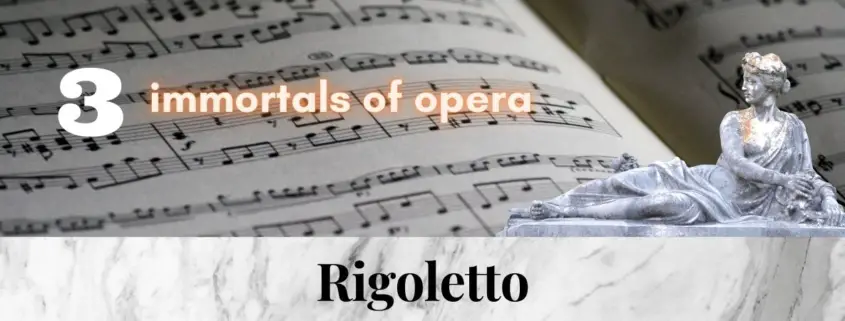The opera is considered Verdi’s first masterpiece and established his worldwide fame. The third act is one of the highlights of the entire opera literature.
The first of the Duke’s famous arias: Questa o quella
With this aria Verdi draws a magnificent portrait of the Count. The music with its simple accompaniment, describes him as a vain, superficial, but charming cynic. He is an egotist who takes all liberties. It is amazing, Verdi gives all the famous melodies of this opera to this negative character.
The aria “Questa o quella” seems at first glance to be a straightforward affair. But in fact, large parts of the aria are written in a high vocal register (but without having a high B or C) and are challenging for tenors with a baritone voice like Caruso or Domingo.
Listen to Luciano Pavarotti’s great interpretation in the Ponnelle film version. His “Questa e quella” is elegant and seductive.
Questa o quella – Pavarotti
The famous aria “Caro nome” of Gilda
This aria springs from the ecstasy of Gilda’s first love. It calls for vulnerability and beauty rather than outward splendor. Gilda is a young woman of 16-18 years. The aria is introduced by the exquisite singing of two flutes accompanied by muted violins. The subsequent repetition of the melody by the singer must produce the brilliance and timbre of the flute. The aria makes the highest demands, for it is peppered with many coloraturas and ornaments and reaches high C twice.
Edita Gruberova has become famous as a coloratura soprano with the role of the Queen of the Night. We hear a singer whose voice can reach the highest spheres and who is a master of the murderous ornaments.
Caro nome / Gruberova
The famous aria “La donna è mobile”
There is an interesting story about this famous aria. Apparently, when Verdi composed this aria, he was aware of how popular it would become and the effect it would have on the audience. Thus, he kept this aria a secret for a long time. To prevent the melody from leaking out before the premiere, even the tenor and the orchestra received the aria only at the last moment, just before the performance. It became a sensation and everyone was humming it as the audience of the premiere left the auditorium.
Again Verdi chose the rhythm of the minuet. The Duke’s personality and intentions remain fixed on the theme of seduction. Still, the aria must be sung lightly and not degenerate into a vulgar piece. It usually ends with a brilliant high B, although Verdi composed it an octave lower. However, no tenor can afford to end the aria with the low B, the audience’s judgment would be scathing.
The incomparable “la donna è mobile” by Pavarotti. With charm, lightness and elegance.
La donna è mobile – Pavarotti







Leave a Reply
Want to join the discussion?Feel free to contribute!